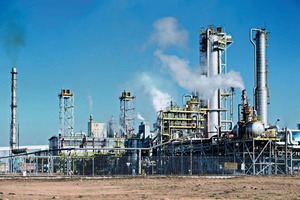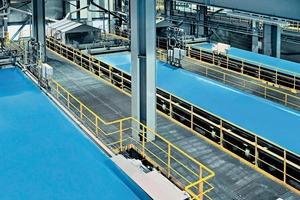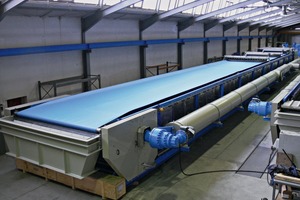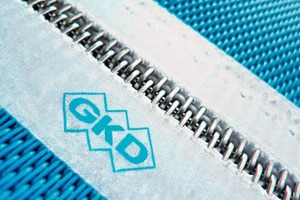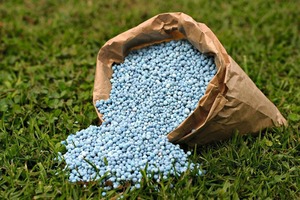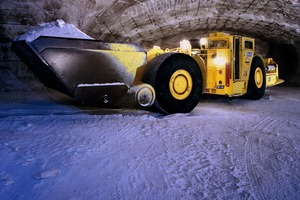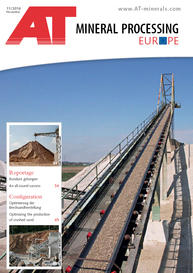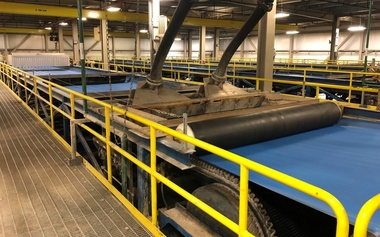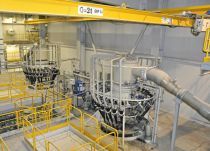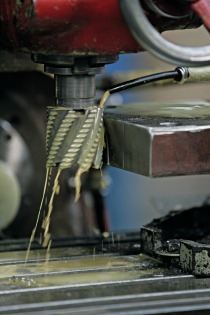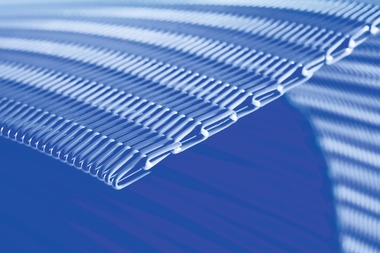More efficiency in fertiliser production
Potassium, nitrogen and phosphorus are the three most important macronutrients in fertilisers. To cater for the global increase in demand for fertilisers, producers all over the world are making massive investments to expand their production capacity and to modernise their existing processing facilities. For the dewatering of phosphogypsum on their vacuum belt filters, more and more of them are using a VACUBELT® 3354 type filter belt made by GKD – GEBR. KUFFERATH AG. This particular woven polyester belt type, which offers a longer service life due to reduced product penetration – especially in the seam zone – and a high degree of lateral stability, ensures more process efficiency in the production of fertilisers.
According to the United Nations, world population will exceed nine billion by the year 2050 – two billion more than in 2016. To feed them all, grain production will have to be increased over the same time period by 46 %. But the UN Food and Agricultural Organization (FAO) calculates that the world’s available arable land for food production will only increase by 4 % by the year 2050. Available arable land will therefore have to produce considerably higher yields. Experts of the German industrial association Agrar e.V. (IVA) are convinced that this higher demand can only be met through the use of mineral fertilisers. In fact, the FAO and the International Fertilizer Industry Association (IFA) both forecast an up to 40 % increase in demand for fertiliser by the year 2030 alone. For phosphorus in particular, the EU Commission even reckons with an increase in demand of around 50 %. Phosphorus is used in both industrial and small-scale agriculture – to the tune of 40 million tons a year. But unlike potassium and nitrogen, phosphorus is a finite resource whose worldwide exploitable reserves are steadily diminishing. And this indispensible fertiliser is irreplaceable by any other substance. For this reason, in May 2014, the European Commission placed phosphate rock on its CRM List of 20 critical raw materials.
Phosphorus production requires versatility
The basic material for phosphatic fertilisers is phosphate rock (apatite), which only occurs in a few regions on the planet. For the purpose of fertiliser production, the apatite is crushed and ground into rock flour. But, because raw phosphates are not readily soluble, this rock flour is only used directly on the fields as fertiliser in rare cases. Usually, through addition of nitric acid, sulphuric acid or phosphoric acid, the phosphate is dissolved and extracted from the rock flour. In this way, raw phosphate is converted into phosphoric acid of different grades of purity. The varying characteristics of the particular phosphate rock used is also reflected in the diversity of treatment processes. For example, particle size and process temperatures will vary depending on the particular raw material. Phosphoric acid production results in the creation of large amounts of phosphogypsum. For this reason of impurities, only 2 % of this type of gypsum can be recycled. After dewatering on vacuum belt filters, the complete remaining volume is bunkered on piles near the fertiliser production facilities.
Demanding process conditions
The world’s largest producers of phosphate fertilisers include companies in Canada, the USA, Russia, Norway and Morocco. To be successful in global competition, their fertiliser production facilities must meet high standards of quality and reliability. At the same time, their efficiency needs to be continuously increased to be able to cater for the constantly rising demand. One crucial contribution to productivity lies in the stability of the filter belts used in gypsum dewatering. These must be able to withstand massive mechanical and corrosive stress at high throughput rates around the clock in order to ensure the longest possible life cycles. For this reason, more and more companies are using a GKD filter belt of the type VACUBELT® 3354 made of polyester monofilaments for the dewatering of their phosphogypsum slurry. With a pore size of 150 μm and an air permeability of 200 cfm, the VACUBELT® filter belt excels through efficient dewatering, a low tendency to clog, and very good cleaning properties. In addition, its smooth surface ensures optimal product detachment. Because it is manufactured on special, high-tech industrial looms, the belt mesh is guaranteed to have the required stability to prevent wrinkling, even in the case of extra-large equipment dimensions. Even belts more than 70 m long and up to 4.5 m wide maintain the requisite lateral stability to ensure the necessary degree of process reliability.
Extension of service life thanks to VACUBELT®
As a rule, the up to 105 °C hot phosphogypsum slurry is spread onto the belt with a cake thickness of about three centimetres and a moisture content of about 80 %. In a continuous process, the vacuum belt filter dewaters the gypsum slurry down to a residual moisture content of 15 - 20 %. In the lab, the producers regularly check that the target dryness is being maintained. If the residual moisture is too high, the respective equipment operator reduces the belt speed in order to increase the moisture being extracted under negative pressure. However, because the aim is to achieve the highest possible throughput of gypsum, the belts have to run at the maximum permissible speed for effective dewatering. The process therefore puts heavy demands on the mechanical, thermal and chemical resistance of the filter belt being used. Product penetration through the belt in the seam zone is a similar liability. This can not only lead to irreparable damage to the vacuum pumps but also destroy the filter belt through abrasion on its underside – a problem that often brings vacuum belt filters to a standstill for several months. Thankfully, with its VACUBELT® 3354 type filter belt, GKD offers a sustainable solution to this problem. The filter belt expert does this by equipping its woven polyester belt with a special version of its patented PAD seam 5, which significantly reduces product penetration. In comparison to conventionally constructed pin seams, the PAD seam is extremely flat and ensures extra grip and easy handling for the company’s process belts. In a hot melting procedure, a special pad is melted into the belt mesh and pressed together with specially formed seam staples. This construction significantly improves the robustness, stability and running characteristics of the filter belt. To guarantee the required corrosion resistance of the seams in such an aggressive environment, GKD uses staples made of hastelloy steel. In this way, this special seam version helps to significantly extend the service life of the vacuum filter equipment.
Adequate success in potash fertiliser production
It is hardly surprising that GKD’s VACUBELT® filter belts are used by the fertiliser industry in more than just phosphoric acid production. They also demonstrate their outstanding efficiency in the potash fertiliser sector in the dewatering of the salt solution. Here, rock salt is separated from the potassium chloride to be used for the fertiliser. High temperatures and corrosive media are characteristic of the process conditions the filter belts have to withstand during dewatering of the salt. Filter belts of the type VACUBELT® 5060 with a pore size of 490 μm are deployed here because – also in this application – the single-layer construction excels through its longer service life and its optimal dewatering efficiency.

